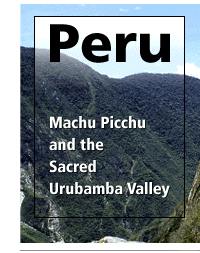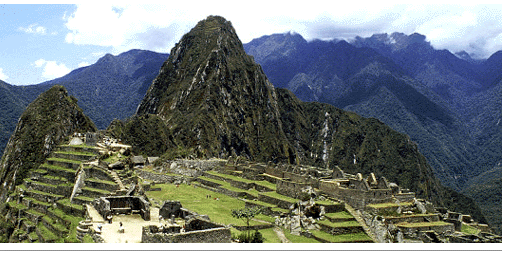|

Peru Cultural Immersion
May 2011, 14-days Trekking in Cordillera Blanca, then Machu Picchu and Cusco area
July 2011, 14-days Machu Picchu and Cusco area then Lake Titicaca, w/ day hikes
This trip is limited to 8 people who wish to have intimate experiences with the country of Peru and our hosts. While we will travel as a group, you will also have ample time to venture off and explore on your own while on this trip.
What We'll Do
Our program includes these components:
- Seeing the sites of Machu Picchu, Cusco, the Sacred Valley and other regions.
- Puno, Lake Titicaca and Amantani Island.
- Service Project
- Hike or two, depending on group and individual interest
- Short Solo
 Activities in Ollantaytambo Activities in Ollantaytambo
These opportunties are a sample of what is available during your
stay at Ollantaytambo.
- Basketry: For generations the Carbajal family has been weaving
"pispita" stem baskets. You may be able to
visit the Carbajal family and learn how to make baskets.
- Blacksmith Shop: Those interested in metal work are welcome
to work on a project of their liking.
- Bread Oven: The firewood bread ovens in Ollantaytambo provide
bread for the entire population of Ollantaytambo. One
can learn how to make bread with the local bread masters.
- Ceramics: The museum ceramics school welcomes anybody interested.
Lucho Soler, the schoolteacher and artist has been working
in Ollantaytambo using pre-Columbian Andean techniques.
- You may also visit the local high school. Urubamba
Market. Shopping for weekly supplies is done at the Urubamba
farmer’s produce and meat market.
- Art and Journaling. drawing, painting and journaling what
one sees is a vital element of experiential learning, One
can be coached and practice on the basics of Pen and Ink,
watercolor and possibly oils or other mediums, and will also
have time to reflect in your journal.
Quechua and Spanish language Learning. Conversational language
learning in the cultural immersion tradition, allows the participant
to learn by doing, not by translating. You will learn the language
with locals to acquire a better understanding of your Peruvian
surroundings.
 Service Project and
Town Work Service Project and
Town Work
- Adobe making, house roofing and field work. River and Inca
Path Cleanup and a Tree Planting Campaign are two service
programs in the area.
- There are a number of local organizations that could use a hand in different aspects of their
work. Individuals may take time to talk to the leaders of
these organizations and see how they can contribute to their
work.
- CATCCO Museum: This is a locally run cultural organization.
Aside from managing the local museum and information center,
it runs a number of community outreach programs.
- TROTUH (The Restaurant of the Universal Heart): This is
a food shelter for out of town kids who walk for between 1
and 3 hours in order to get to school.
- ECOAN: works in the communities surrounding
whose main objective
is to protect the endangered native Polilepis "Qeuña"
forests.
- Inca Porter Project: This organization, is working to help porters who work
on the Inca trail to Machu Picchu to improve their working conditions, by helping them negotiate
with travel agencies in the area and offering them training
in basic skills, especially English.
 Visiting
Important Historical Sites Hiking Visiting
Important Historical Sites Hiking
You
could be hiking at high altitude in the backcountry, along remote
parts of the countryside that most tourists rarely see.
We will also visit many of the amazing important ruins in the
area.
Quechua - Indigenous Elders Speak
We will visit with village Elders and learn their perspectives of their place in the world and how Inca and Quechua culture relate to the Pacha Mama or Earth Mother, and may, if you wish, participate in ceremony/ies and prayer honoring the Pacha Mama and Mountain Spirits or Apus in the area.
Solo Experience
A short solo can be part of the expedition, depending on
location and conditions. It’s a time to rest on your own
in a beautiful mountain location, to reflect on what the trip
has meant to you and to start thinking about how you will transfer
what you have learned back to your life in the US.
Return to Top of Page

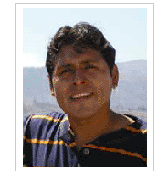 Guillermo Seminario: Cusco, Peru Guillermo Seminario: Cusco, Peru
Guillermo the musical director for the band Chimu Inka in Cusco, Peru has all but finished his training as a certified guide in Peru. He will be our host and help organize details about our trip. He is well versed on the history and culture of Peru. He also coordinates the Cusco Music Exchange for MSI and has been in the USA under special invitiation from MSI in the fall of 2008. He is a talented performer, having played various instruments since an early age.
Of course Peruvian folklore music may just be a part of this program too! As Guillermo says, "Just as we depend upon the sun, we can't exist without the strength, warmth and inspiration of music." Guillermo speaks Spanish, Quechua and English.
R. Richards
R. Richards has guided and taught individuals, clients,
and participants throughout South America, the European Alps
and the Western US since 1981. He has been a senior guide for
Alpine Ascents International on Aconcagua, Argentina and four
of Ecuador’s major volcanoes, and expedition co-leader
on Mt. Huascaran, Peru, as well as a respected instructor on
Mt. Baker...read more.
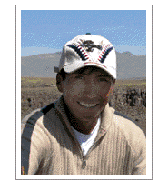 Richard Cari: Amantani Island, Lake Titicaca, Peru Richard Cari: Amantani Island, Lake Titicaca, Peru
Richard and his parents Sigundino and Marcelina Cari, own the Kantuta Lodge on the Island of Amantani on Lake Titicaca, Peru. Richard is a graduate of the Puno University and studied tourism and hospitality. Since graduating from the University, Richard and his family have been improving the family lodge which lies just meters from the shores of Titicaca. Sigundino is a former town official and assistant to the head shaman on the island. Richard Speaks Spanish, Quechua, English and Aymara.
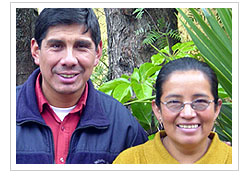 Jorge Martel: Huaraz, Peru Jorge Martel: Huaraz, Peru
Jorge is a veteran Peruvian mountain guide in the Andes’ Cordillera Blanca range in Peru. He is a past president of the Peruvian Mountain Guides Association, and has studied tourism and hospitality in Austria. His experience and knowledge of the high Peruvian Andes is substantial. He is a founding executive member of the cultural non-profit group Llama 2000, a program dedicated to bringing sustainable environmentally and culturally sensitive backcountry programs to his native Ancash region of Peru. Jorge speaks Spanish, English, German, French and Quechua.
Return to Top of Page

Mountain Spirit suggests that you purchase a guide and Spanish or Quechua language book from our reading list, and learn a few phrases of Spanish. Please contact us for our reading list.
Health
Your MSI staff on this expedition includes Randy
Richards, an Emergency Medical Technician, to take care
of you while you're with us. Before you leave, however, The
Center for Disease Control CDC recommends the following vaccines;
see your doctor at least 4–6 weeks before your trip to
allow time for immunizations to take effect.
- Hepatitis A or immune globulin (IG).
- Hepatitis B, if you might be exposed to blood (for example,
health-care workers), have sexual contact with the local population,
stay >6 months in the region, or be exposed through medical
treatment.
- Yellow fever vaccination, if you will be traveling outside
urban areas.
- As needed, booster doses for tetanus-diphtheria and measles.
- Anti-malarial drugs are not necessary for this trip (per
MSI).
For more information on CDC recommendations, please visit their
web
site.
Our Peru expedition may include hiking at high
altitudes; for this reason, you should be healthy and fit enough
to endure the hiking/ portions of our program.
Supplies and Belongings
Come prepared with an open mind, bring a journal, and if you
like to draw or watercolor, this is the program for you.
There are people who have traveled for ten years in Peru and
never had anything stolen. There are others who have traveled
for one month and have had things taken from them ten times.
One can very easily take precautions. We recommend reading Lonely
Planet’s instructions about traveling safely.
You can purchase most everything in Cusco that you'll need
(shampoo, razors, socks and t-shirts, etc.), so you may want
to buy some of these items there. Certainly, traveling light
on the plane and buying a sweater in Cusco is a good way to
go. However Gore-tex or similar rainwear is better purchased
in the US. Consider also purchasing a large colorful Peruvian
duffle bag once you are there for taking gifts back to the US.
In short, pack for hiking and camping, as well as relaxing.
For suggestions on what to bring along with you, please contact
us and we'll be happy to help.
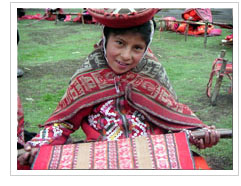 Language Language
We ask that you study the language before you go. A bit of
effort to speak the language goes a long, long way with the
local people. We can’t emphasize this enough. Knowing some
basic Spanish and a few Quechua words will do more than anything
else to put you in closer touch with the people of Peru. Learning
the basics is easier than you might expect. Start with Spanish
tapes or a fun picture book with removable stickers of Spanish
words (which one can put on light switches, night tables, and
toothbrush).
Randy speaks fluent Spanish and basic phrases in Quechua. The
other staff speaks fluent Spanish, as well as Quechua and English.
Some shop owners may speak a little English. If you find yourself
in a bind, you probably won’t have a long wait before someone
comes to your rescue. However, our expectation is that you will
have learned some basic Spanish prior to our expedition, as
a courtesy to your hosts.
Return to Top of Page

Altitude
Taking it slowly the first few days to allow time for your
body to acclimate is the most important rule for adjusting to
altitude. By the time we embark on any significant hiking or
climbing, you will be fairly well adjusted to the altitude.
Your guides and facilitators will use the old program of 'climbing
high and sleeping low' to properly acclimate. Cusco is at 3362
Meters (about 9500 ft.) and higher than Machu Picchu, so one
should plan on taking it a bit easy the first day.
Money, Credit Cards and Debit Cards
Cash advances and debit machines are easily accessed in Cusco
and Lima, however we have found that VISA is much more widely
used than Mastercard. Have a backup card carried in a separate
place. Transfers from Savings to your checking is also possible
in some locations but not all. Traveler’s checks may be
cashed at some locations. Have a photocopy of your passport in a separate location in your luggage
Communications
- PHONE: having a calling card will be useful or better yet,
you can purchase a Peruvian calling card and use it for calling
the US.
- EMAIL: There are public computer
booths/stalls where you can log onto the web for approx. $.50/hour.
Having a web-based email such as Yahoo! or Hotmail is free,
so you only pay the hourly rate. It can save a bundle on phone
calls.
- MAIL: Peruvian stamps aren’t the cheapest but are works
for art. Regular mail’s reliability has improved somewhat,
especially for letters, which take about 2-3.5 weeks in delivery
time. Mailing valuables, and any packages for that matter, is
not recommended.
- FAX: easily available, but more expensive than email, in many
shops in town.
- SKYPE INTERNET CALLING:
Web based program available at all internet booths that allows free high quality international calling and video calling to and from Internet café computers. Simply create your own account and open it on any computer to start calling other Skype users or regular telephones for about .02 cents per minute
Return to Top of Page

Peru Machu Picchu, Cusco, & Lake Titicaca: $2950.00
Peru Trekking Cordillera Blanca/Machu Picchu & Cusco: $3221.00
(Both based on 6 people in the group. Price varies depending on number of particpants. )
International and in-Peru air travel is not included.
(US and in-Peru air costs are estimated at Estimate $750.00, based
on rates provided for roundtrip airfare for BOS/LIMA/BOS
and LIMA/CUSCO/LIMA).
This sum is included as courtesy but will vary.
INCLUDED
- All Ground Transportation while in the Cusco/Lake Titicaca Region
- Three Daily Meals*
- Experiential Activities in Olltaytambo/Willoc
- All Accommodations in the Cusco/Lake Titicaca Region
- Entrance Fees for Ruins of Machu Picchu
- All Guide fees
*NOT included are 3 meals in Cusco and towns (with an average
cost of $3-4 per meal), which allow participants freedom to explore
a number of restaurants on their own.
NOT INCLUDED
- International and In-country air transportation
- Ground Transport in Lima if you decide to stay in Lima which is optional
- Accomodations in Lima if you decide to stay in Lima which is optional
- Compensation for consequences of flight delays or Acts of
God
- Tips and gratuities
- Trip Cancellation or Travel Insurance (highly recommended)
- Entry into Cusco Ruins (approx. $15.00)
- Snacks and sodas or any alcohol
- Donations
- Immunizations, medical costs or health insurance, (which includes
an international medical evacuation)
- Peru airport departure taxes in Lima and Cusco ($35.00-$38.00 total)
Return to Top of Page

College credit may be available for you on this program. Please inquire.
Mountain Spirit Institute is a fully insured and federally recognized
510 (c) 3 Non-Profit Educational Organization.To receive information
on optional college credit please contact
us.
Return to Top of Page
PHOTO CREDIT: R Richards |


